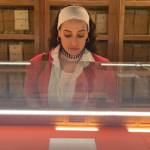
Prof. Claudia Hopkins, recipient of the inaugural Mark A. Roglán Publication Award
The Custard Institute is pleased to announce that the recipient of the inaugural Mark A. Roglán Publication Award is Prof. Claudia Hopkins for the catalogue Romantic Spain. David Roberts and Genaro Pérez Villaamil (2021).
This award, in the amount of $2,500, recognizes exemplary scholarship on Spanish art from 1820 to 1920.
The award is named for the late director of the Meadows Museum, Mark A. Roglán, an eminent museum professional and art historian whose field of specialization was Spanish art of the modern period and its collecting history. Each year, the award honors a single distinguished publication. Publications eligible for the inaugural 2023 award must bear an imprint date from 1 January 2020 to 31 December 2022. Subsequent awards will be presented annually and recognize publications from the previous calendar year.
David Roberts (1796–1864) and Genaro Pérez Villaamil (1807–1854) were two of the most important landscape painters of European Romanticism. Their views of Spanish monuments, cities, and landscapes helped forge a ‘Romantic image’ of Spain. Adopting a comparative approach, six essays and over 120 catalogue entries written by eleven experts led by Hopkins, curator of the eponymous exhibition (Real Academia de Bellas Artes de San Fernando, October 2021–January 2022) and editor of this volume, cover the trajectories of both artists, starting with their first encounter in Seville in 1833. The book was published by the Real Academia de Bellas Artes de San Fernando, the Centro de Estudios Europa Hispánica (CEEH) —organizers of the exhibition— and the Instituto Ceán Bermúdez. In 2022 it received the inaugural Jonathan Brown Award from the Society for Iberian Global Art (SIGA) for exceptional achievement in an exhibition catalogue.
“Romantic Spain has immense scholarly merit. It is more than a sum of its parts, for through Roberts and Villaamil broader notions of Spanishness and its representation are scrutinized, often from new angles. The book is also a visual delight.” Chloe Sharpe, Hispanic Research Journal 23.5, 2022.
“The neglect (of Roberts and Villaamil) alone may be enough to justify the interest in exhibiting the work of the two artists. But interestingly, Romantic Spain goes beyond a mere rescue-operation. … It is an original case study of both cross-cultural influence and national identity formation.” Javier Ortiz-Echagüe, Nineteenth-Century Art Worldwide, Autumn 2022.
Claudia Hopkins, Ph.D., is Professor of Art History at Edinburgh College of Art at the University of Edinburgh. She is Honorary Professor in Hispanic Art at Durham University, where she served as the Director of the Zurbarán Centre for Spanish and Latin American Art from 2020 to 2023. Focusing on nineteenth- and twentieth-century art and visual culture, her research explores constructs of self and others, issues of identity, and processes of translation. Between 2015 and 2020, she co-led the collaborative research project on pan-European art criticism on the art of the United States, funded by the Terra Foundation for American Art. The main outcome was the two-volume book Hot Art, Cold War–Western and Northern European Writing on American Art 1945-1990 and Southern and Eastern European Writing on American Art 1945-1990, co-edited with I. B. Whyte (Routledge, 2020). In 2018–2019 she was awarded a Leverhulme Fellowship for Rethinking Orientalism. Spanish attitudes to al-Andalus and Morocco. Hopkins also made a major contribution to the exhibition and publication The Discovery of Spain: British Artists and Collectors: Goya to Picasso (National Gallery of Scotland, Edinburgh, July – October 2009).
Hopkins has been editor of the Getty-funded journal Art in Translation since 2023. Her forthcoming book Spanish Art and Identity 1833-1956. The Orient Within (Bloomsbury, 2024) investigates how Spanish artists shaped perceptions of Al-Andalus and Morocco, from Spain’s liberal revolution of the 1830s to the end of the Protectorate of Morocco under Franco.
If you have a comment, please email The Custard Institute.










